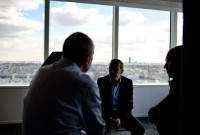- Home
- Business Processes
- Industry Knowledge
- Aerospace Industry
- Automotive Industry
- Banking Domain
- BFSI Industry
- Consumer/ FMCG Industry
- Chemicals Industry
- Engineering & Construction
- Energy Industry
- Education Domain
- Finance Domain
- Hospitality Domain
- Healthcare Industry
- Insurance Domain
- Retail Industry
- Travel and Tourism Domain
- Telecom Industry
- Leadership Skills
- eLearning
- Home
- Leadership Skills
- Leadership Theories
- Role Theory of Leadership
Role Theory of Leadership
Role theory is a concept in sociology and the role theory of leadership borrows these concepts to explain how people adapt to specific organizational and leadership roles. How the leaders and followers in an organizational context define their own roles, define the roles of others, how people act in their roles and how people expect people to act in their roles within the organization.
What is Role Theory?
Role Theory is a perspective in sociology and social psychology. Role Theory proposed that human behavior is guided by expectations held both by the individual and by other people. The expectations correspond to different roles individuals perform or enact in their daily lives, such as secretary, father, or friend. The model is based on the observation that people behave in a predictable way, and that an individual’s behavior is context specific, based on social position and other factors. Each social role is a set of rights, duties, expectations, norms and behaviors that a person has to face and fulfill. Roles are occupied by individuals, who are called "actors".
Role Theory of Leadership:
Role theory as it relates to organizational leadership is how the leaders and followers in an organizational context define their own roles, define the roles of others, how people act in their roles and how people expect people to act in their roles within the organization. The basic assumptions is that the leaders often define their own roles within an organization based on the how the employees see the leader’s role. This theory is based on the assumptions from social role theory that people define roles for themselves and others based on social learning and reading and they form expectations about the roles that they and others will play. People also encourage others within their social circle to act within the role expectations they have for them and they themselves try to act within the roles they adopt.
How it Works?
Associated with every work environment is a set of activities or roles that are defined as potential behaviors to be performed in accordance with a specific job. Within organizations, there exist both formal and informal channels to convey these expectations about leader's role. Formal role theory reveals itself through policies and positions set by upper management. Examples of formal channels are leadership values training, explicit leadership behaviors at different levels/bands, organizational culture, training sessions, mentoring by senior managers, and so on.
Informal role theory reveals itself through the expectations of followers. Employees have internal representations about the role of leaders, based on what they read, discuss, hear, observe and so on. They consciously or unconsciously send these expectations to their leaders, acting as role senders, for example forwarding an important customer escalation mail to the manager for decision and guidance in-spite of employee knowing the desired actions to resolve the same. This balancing of decisions employees take upon ourselves and the ones that they leave on their leaders pass these subtle expectations to the leader. Leaders get influenced by these signals, and will generally adapt and follow these, playing the leadership role that is put upon them by their followers.
Role Theory Terms:
Role expectations of a leader can vary from very specific to a broad idea within which the leader can define their own style. Given below are definitions of some common terms used in context of Role Theory of Leadership.
Role Set refers to any feature of the organization that is able to send role expectations/requirements and role pressures to the manager.
Role expectations refer to the degree to which all members of the manager's role set develop beliefs and attitudes about what the manager should and should not do as part of his/her role.
Sent role refers to the fact that role expectations are sent to the focal person (e.g., manager).
Role pressures refer to the numerous influence attempts directed at the focal person that make up the process of role sending.
Role forces are regarded as psychological forces of some magnitude and direction that result from sent pressures by role senders and are the immediate source of the manager's motivation to behave.
Role behavior is a system relevant behavior that is performed by one who is an accepted member of the system, and whose behavior is reinforced by the formalities of the organization.
Role Conflicts: According to role theory, role conflict is a possible experience for leaders within a business or organization. When the employees in a business have a set of expectations on the role of the leaders that are different from what the leaders accept as their role, role conflict can occur. Role conflict can also occur when different people have differing expectations of their leaders. It also happens when leaders have different ideas about what they should be doing compared to the expectations of followers or management. Similarly role conflict can also occur when a leader feels they should be performing a certain role but employees expect the leader to fill a different role.
Related Links
You May Also Like
-
There are four characteristics of leadership that help us to understand the character of leadership as a concept. 1. Leadership is a process, 2. Leadership involves influence, 3. Leadership always occurs in a group context and 4. Leadership involves goal attainment. These are the four components that make up the character of the 'leadership' term and help us to define the leadership concept. All of these components of leadership have common characteristics.
-
Jung first introduced his personality theory and explained that all humans have a natural impulse to relate meaningfully to the world through productive work and people through significant relationships. He used four psychological functions - thinking and feeling (rational functions) and sensation and intuition (irrational functions). He also used introversion and extraversion and its impact on appropriate leader behaviors.
-
Idiosyncrasy Credit Model of Leadership builds upon the awareness that when the emergent leader meets the team's expectations, idiosyncrasy credits are awarded. These credits depend on how the leader fulfilled follower's expectations and what is the impact of the leader's decisions on the follower. When the balance of credits shifts, another leader will emerge.
-
The cognitive resource theory states the influence of the leader's resources on his or her reaction to stress. The cognitive resources of a leader are experience, intelligence, competence, and task-relevant knowledge. Stress is common in resource managing situations, and this cognitive theory emphasizes how intelligence and experience are each best under different stress situations. This theory is the reconceptualization of the Fiedler model.
-
Hawthorne Studies - Leadership
The Hawthorne studies were conducted on workers at the Hawthorne plant of the Western Electric Company by Elton Mayo and Fritz Roethlisberger in the 1920s. This study established the behavioral change that happened due to an awareness of being observed, resulting in active compliance with the supposed wishes of researchers, because of special attention received, or positive response to the stimulus being introduced.
-
The Systemic Approach to Leadership
The systemic approach to leadership looks at the organization as a whole and focuses on the understanding of the organization as a system. Moving to systems thinking demand managers to view organizations as organic systems. Leaders are also part of this complex system which is constantly undergoing change and evolving. The leaders need to manage the relations and networks within these systems by acting with systemic awareness.
-
All the teams are dynamic in nature and they take time to come together, they form, develop, and grow in stages, over a period of time. Teams go through five progressive stages: Forming, Storming, Norming, Performing and Adjourning. In this article, we want to introduce you to these stages of team development and certain strategies that you can use to help the team grow and develop in each of these stages.
-
In this study of power, Raven identified five bases of power as coercive, reward, legitimate, referent, and expert. The 5 Types of Power can help you decide when it is appropriate to use a particular type of power in important situations. Leadership involves authority and it is very important for leaders to understand what type of power they're using.
-
The Path-Goal theory defines the characteristics of followers and organizational context and the corresponding leadership style best suited to these factors. A leader should adapt to a behavior that is most relevant for a given employee and work environment mix to achieve a goal. The application of theory drives increased employees' motivation, empowerment, and satisfaction resulting in increased productivity.
-
Continuum of leadership is a leadership theory based on the relationship between the level of freedom given to the team and the level of authority used by the manager. The chosen leadership style will depend on multiple factors, including the leader's personality.
Explore Our Free Training Articles or
Sign Up to Start With Our eLearning Courses

About Us
Learning
© 2023 TechnoFunc, All Rights Reserved










